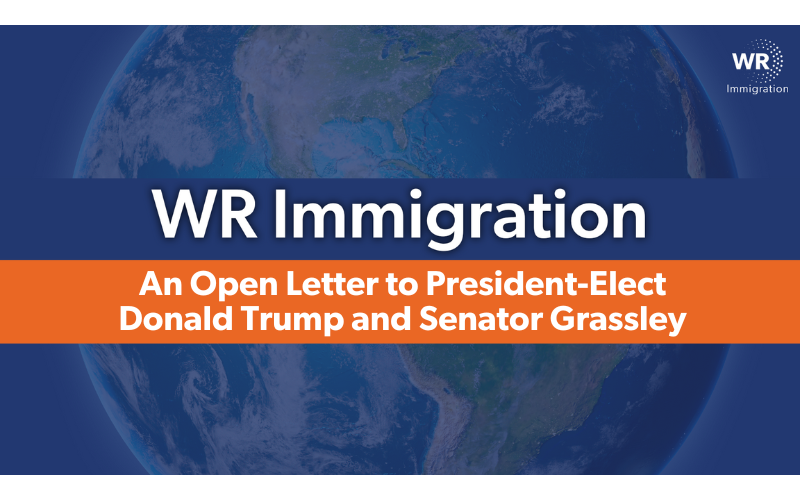Dear President-Elect Trump and Senator Grassley,
Thank you, Senator Grassley, for successfully introducing and piloting the bipartisan EB-5 Immigrant Investor Reform and Integrity Act, signed into law in March 2022. In a few months, we will approach the three-year anniversary of this new law, and it’s clear the law is a huge success. At least 7,700 applicants have applied through the EB-5 Program, injecting a minimum of over $6 billion dollars of foreign direct investment, to be used for the creation of hundreds of thousands of direct and indirect rural and high-quality employment area jobs in the United States. However, less than 1,000 green cards have been issued to these new immigrant investors, and the EB-5 Program expires in less than three years, and the law needs to be tweaked.
President-Elect Trump, below are three things you can do to improve Senator Grassley’s bipartisan EB-5 Reform and Integrity Act (RIA) program. I am confident that both Senators Grassley and Schumer will support this because it will create even more jobs in high unemployment and rural areas. It will also inject billions into the U.S. economy and create thousands of jobs without costing the government or American people one penny.
- Need to increase the number of visas annually from the current 10,000 visas (about 3,500 investors and their families). We need to increase this to 10,000 investors and their families as most of these visas go to backlog categories and only about 3,200 go to new investors, which is only about 1,000 investors and their families. This, by itself, could bring 3X the number of direct foreign investment already invested into the United States and create tens of thousands of more direct and indirect jobs.
- Introduce faster, premium processing to improve adjudications. Add a $25,000 additional filing fee to provide 30-day final adjudications. Presently it is taking 2-3 years to adjudicate petitions and get the green card, and this makes no sense. Also allow these investors with approved petitions to be processed abroad as pre-immigrants, much like K-1 fiancés of U.S. citizens who can enter after screening and have 90 days to apply for green cards.
- Investors who have invested in good faith but whose projects have failed through no fault of their own should be able to keep their place in the waiting line by making a second investment rather than be deported after spending years in the U.S. if their “at risk” investment fails.
Immigrant investors through the EB-5 Program create jobs for U.S. workers, and their admission brings billions in investment and thousands of jobs annually. Most EB-5 investors bring in millions in addition to their initial investment by buying homes, starting businesses and spending on their children’s education. President-Elect Trump please act to improve this program that has brought over $6 billion of direct foreign investment in less than three years and has created thousands of new jobs in rural areas and high unemployment areas.
Thank you, Senator Grassley, on your introduction of a good law that now needs to be made permanent and improved upon.
Thank you, President-Elect Trump, for your leadership on this issue.
Respectfully,
Bernard P. Wolfsdorf
Managing Partner
WR Immigration
Past President American Immigration Lawyers Association


